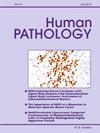新辅助化疗对口腔鳞状细胞癌PD-L1表达的影响:一项匹配的活检-切除研究。
IF 2.6
2区 医学
Q2 PATHOLOGY
引用次数: 0
摘要
背景:程序性死亡配体1 (PD-L1)对免疫逃避至关重要,是口腔鳞状细胞癌(OSCC)免疫治疗的重要生物标志物。然而,其在新辅助化疗(NACT)后表达的变化尚不清楚。本研究旨在评估匹配的预处理活检样本和nact手术样本之间PD-L1表达的变化,同时将这些结果与临床病理特征联系起来。材料和方法:本研究纳入130例OSCC患者,其中95例接受NACT治疗,35例作为对照组,未接受NACT治疗。采用肿瘤比例评分(TPS)、免疫比例评分(IPS)和联合阳性评分(CPS)在几个截断点(≥1%、≥10%、≥25%和≥50%),通过免疫组织化学(SP263克隆)检测预处理活检样本和相应的nact切除后标本上PD-L1的表达。采用SPSS 24.0版本进行统计评价。结果:NACT后,PD-L1表达有明显变化。PD-L1 TPS在T1肿瘤中显著降低,从43.4%下降到13.0% (p=0.039),在侵袭深度(DOI)小于5mm的肿瘤中,PD-L1 TPS从40.7%下降到14.8%。相反,PD-L1在淋巴结晚期、淋巴血管侵袭(LVI)、神经周围侵袭(PNI)和肿瘤出芽的肿瘤中表达增加。联合阳性评分(CPS)的变化与肿瘤出诊(p=0.008)、最坏侵袭模式(WPOI) (p=0.036)、DOI (p=0.030)和预后分期(p=0.026)有显著相关。在对照病例中,在活检和切除标本之间仅检测到PD-L1状态的微小改变。结论:NACT未引起OSCC中PD-L1表达的均匀或广泛变化。显著的改变仅限于T1肿瘤的TPS和与某些病理特征相关的CPS,而大多数其他比较没有统计学意义。这些发现提示,NACT术后PD-L1表达应谨慎解读,需要更大规模的研究来阐明其临床相关性。本文章由计算机程序翻译,如有差异,请以英文原文为准。
Impact of neoadjuvant chemotherapy on PD-L1 expression in oral squamous cell carcinoma: A matched biopsy-resection study
Background
Programmed death ligand 1 (PD-L1) is essential for immune evasion and serves as a significant biomarker for immunotherapy in oral squamous cell carcinoma (OSCC). Nevertheless, the changes in its expression after neoadjuvant chemotherapy (NACT) are not well understood. This research sought to assess the variations in PD-L1 expression between matched pretreatment biopsy samples and post-NACT surgical specimens, while also correlating these results with clinicopathological characteristics.
Materials and methods
The study comprised 130 patients with OSCC, of which 95 were treated with NACT while 35 acted as controls who did not receive NACT. PD-L1 expression was measured via immunohistochemistry (SP263 clone) on pretreatment biopsy samples and corresponding post-NACT resection specimens, employing Tumor Proportion Score (TPS), Immune Proportion Score (IPS), and Combined Positive Score (CPS) at several cut-off points (≥1 %, ≥10 %, ≥25 %, and ≥50 %). Statistical evaluations were performed using SPSS version 24.0.
Results
In post NACT, there was a significant variation in PD-L1 expression. A marked reduction in PD-L1 TPS was noted in T1 tumors, decreasing from 43.4 % to 13.0 % (p = 0.039), as well as in tumors with a depth of invasion (DOI) less than 5 mm, which dropped from 40.7 % to 14.8 %. Conversely, an increase in PD-L1 expression was observed in tumors at advanced nodal stages and those exhibiting lymphovascular invasion (LVI), perineural invasion (PNI), and tumor budding. The change in combined positive score (CPS) was significantly correlated with tumor budding (p = 0.008), the worst pattern of invasion (WPOI) (p = 0.036), DOI (p = 0.030), and prognostic stage (p = 0.026). In control cases, only minor alterations in PD-L1 status were detected between biopsy and resection specimens.
Conclusion
NACT did not lead to uniform or widespread changes in PD-L1 expression in OSCC. Significant alterations were limited to TPS in T1 tumors and CPS associations with certain pathological features, while most other comparisons showed no statistical significance. These findings suggest that PD-L1 expression after NACT should be interpreted cautiously, and larger studies are needed to clarify its clinical relevance. Keywords: Oral Squamous Cell Carcinoma; PD-L1 expression; Neoadjuvant treatment; Prognosis; Tumor proportion score; Combined positive score.
求助全文
通过发布文献求助,成功后即可免费获取论文全文。
去求助
来源期刊

Human pathology
医学-病理学
CiteScore
5.30
自引率
6.10%
发文量
206
审稿时长
21 days
期刊介绍:
Human Pathology is designed to bring information of clinicopathologic significance to human disease to the laboratory and clinical physician. It presents information drawn from morphologic and clinical laboratory studies with direct relevance to the understanding of human diseases. Papers published concern morphologic and clinicopathologic observations, reviews of diseases, analyses of problems in pathology, significant collections of case material and advances in concepts or techniques of value in the analysis and diagnosis of disease. Theoretical and experimental pathology and molecular biology pertinent to human disease are included. This critical journal is well illustrated with exceptional reproductions of photomicrographs and microscopic anatomy.
 求助内容:
求助内容: 应助结果提醒方式:
应助结果提醒方式:


